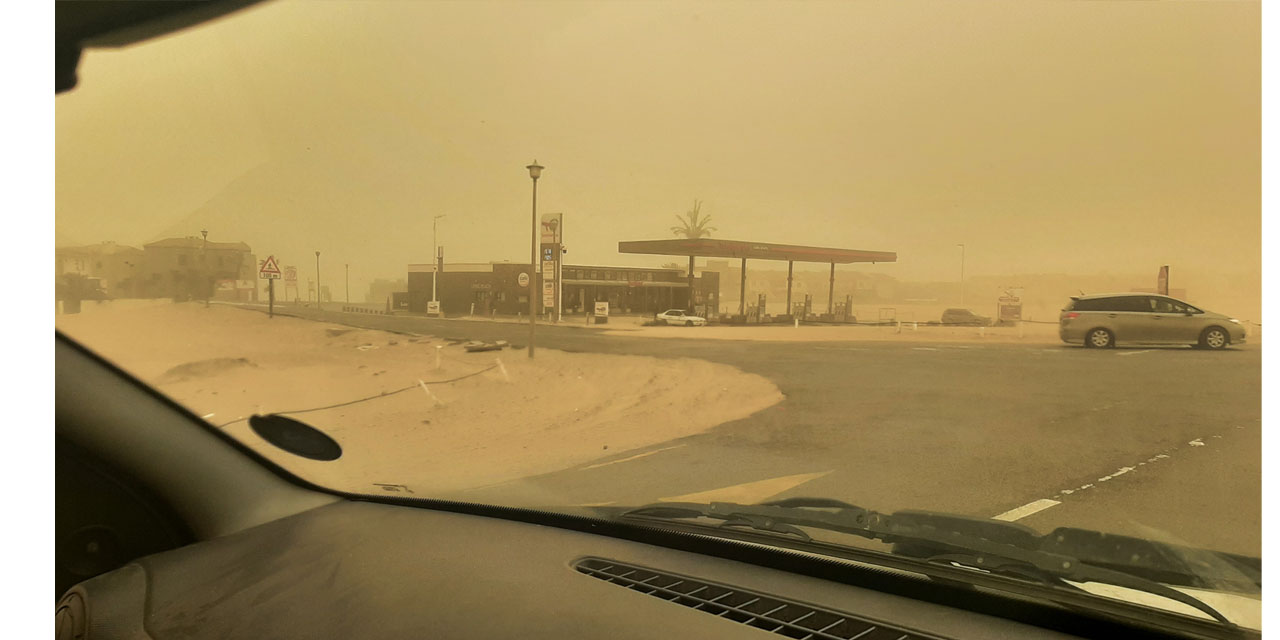Niël Terblanché
A giant cloud of dust and sand, caused by strong east winds, has enveloped the three major towns of Namibia’s central coastal region.
At the same time, Inspector Ileni Shapumba, Head of the Community Affairs Division of the Namibian Police in the Erongo Region, has warned motorists to take extra precaution while driving on the roads between the three main coastal towns of Walvis Ba, Swakopmund and Henties Bay because of extremely low visibility.
The entrance to Walvis Bay had to be cleared by heavy earthmoving machinery after gale-strength winds blew sand onto the road surface on Monday night.
In some places, the sand dunes that formed in the entrance road were high enough for drivers to get their vehicles stuck in the soft sand while driving on the main road.
Traffic officials from Walvis Bay had to redirect motorists while earthmoving machinery had to be used to pull stuck vehicles out of the soft sand. The front-end loaders of the municipality of Walvis Bay cleared most of the sand from the road surface after wind speeds subsided to moderate on Tuesday morning.
The strong winds during the night also ripped the roof off the house of at least one resident of Walvis Bay.
At the same time, residents of Lüderitz and Oranjemund also had to deal with strong east winds that blew sand onto the main roads connecting the coastal towns to the interior of Namibia.
Motorists on their way to Aus also got stuck in the sand dunes that were formed on the road surface. Some drivers travelling between the two southern towns decided not to risk getting stuck in the sand and were forced to turn around and go back to where they came from.
Satellite images of Namibia indicated that strong easterly and north-easterly winds also picked up a huge dust plume from the Etosha Pan. The image shows a dust cloud of at least 300 kilometres long moving west while huge dust clouds can be seen blowing for about 400 kilometres into the Atlantic Ocean.
Senior weather forecaster of the Namibia Meteorological Service, Richard Nashikaku, said the dense dust and sand cloud experienced by the residents along the coast was caused by the prevailing easterly winds that threatened to reach gale strength during the night.
“Although this kind of weather phenomenon is more common over parts of the Sahara Desert and does occasionally occur over parts of southern Africa. The cold air over the interior descends from the escarpment and picks up speed as it goes along. The temperature of the descending air also rises and causes east wind conditions at the coast,” he said.
Nashikaku explained that the dust and sand are picked up by strong winds elsewhere over the interior of the southern parts of Africa and carried high up into the sky. The sand and dust are then deposited as the wind loses its strength. He compared the process to a whirlwind but on a much larger scale.
According to Nashikaku, the east wind conditions are expected to continue for the next two days over large parts of the Namibian coast.
He said that the east wind conditions at the coast will start to subside by Thursday.
With regard to the extreme cold that residents have experienced over the southern and central parts of the country, Nashikakusaid that temperatures will slowly start to rise.
“The sub-zero temperatures experienced over large parts of the Namibian interior over the past two days will subside and by Thursday normal winter temperatures will return,” he said.
He added that another strong cold front is set to move over the southern parts of Africa by Friday and that colder temperatures over the interior of Namibia might start to occur again over the coming weekend.




